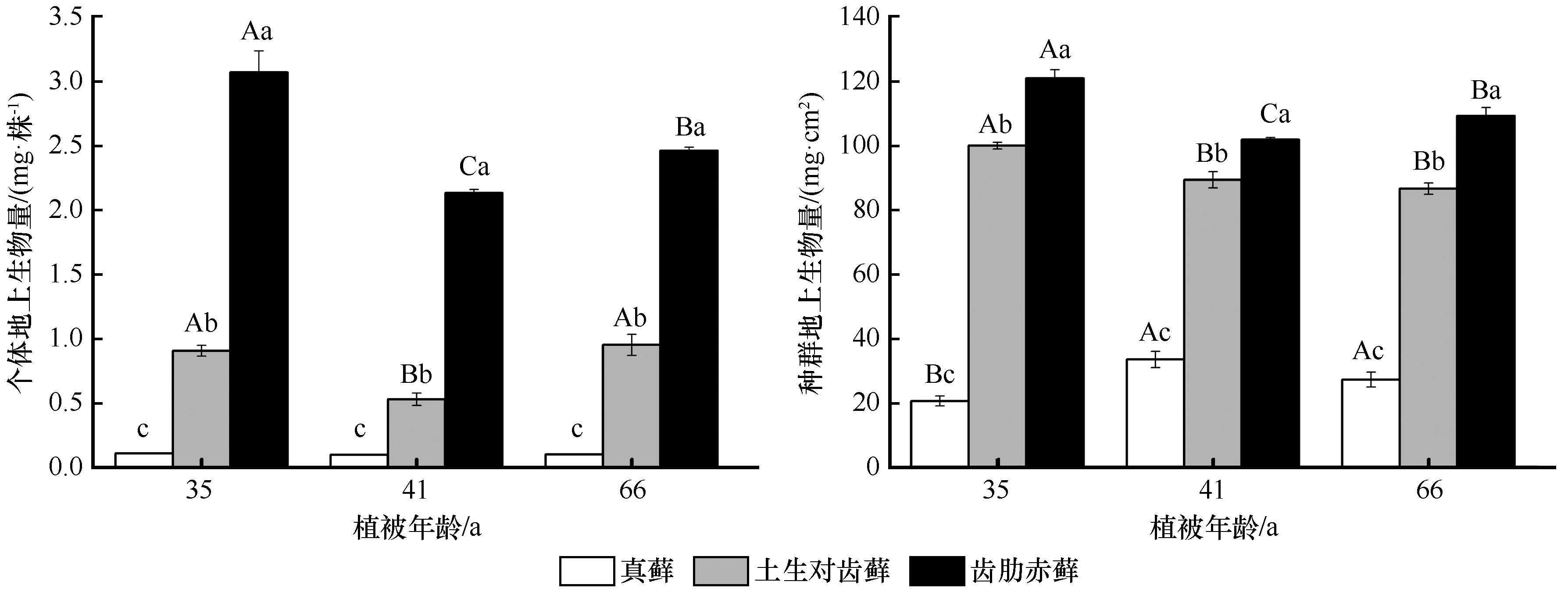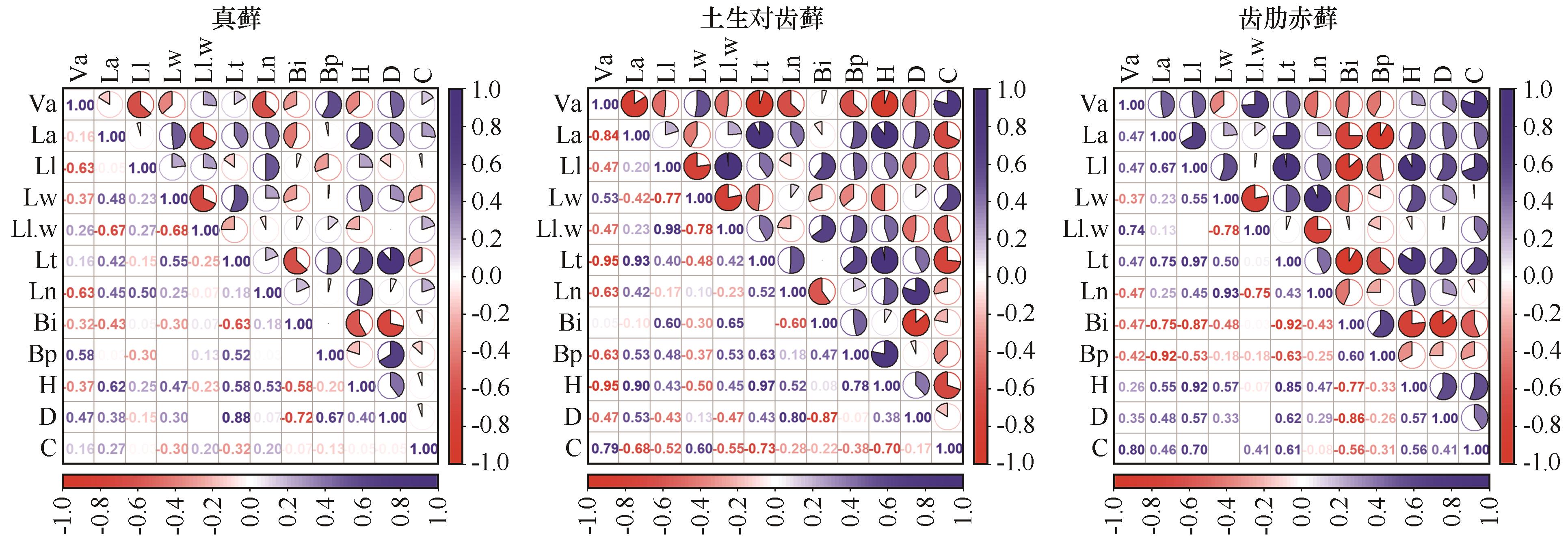
- CN 62-1070/P
- ISSN 1000-694X
- Bimonthly 1981

Journal of Desert Research ›› 2024, Vol. 44 ›› Issue (3): 298-307.DOI: 10.7522/j.issn.1000-694X.2023.00119
Yuchen Wan1,3( ), Yanping Liu1, Yongsheng Wu4, Hongfei Jia1, Tian Zhang1, Yanhong Gao1, Haotian Yang1, Wanxue You5, Jun Du2, Rongliang Jia1(
), Yanping Liu1, Yongsheng Wu4, Hongfei Jia1, Tian Zhang1, Yanhong Gao1, Haotian Yang1, Wanxue You5, Jun Du2, Rongliang Jia1( )
)
Received:2023-09-23
Revised:2023-12-29
Online:2024-05-20
Published:2024-06-11
Contact:
Rongliang Jia
CLC Number:
Yuchen Wan, Yanping Liu, Yongsheng Wu, Hongfei Jia, Tian Zhang, Yanhong Gao, Haotian Yang, Wanxue You, Jun Du, Rongliang Jia. Morphologic evolution features of mosses in artificial sand-fixing vegetation in the Tengger Desert[J]. Journal of Desert Research, 2024, 44(3): 298-307.
Add to citation manager EndNote|Ris|BibTeX
URL: http://www.desert.ac.cn/EN/10.7522/j.issn.1000-694X.2023.00119
| 藓种 | 茎叶体 | 茎 | 叶片 | 叶尖 |
|---|---|---|---|---|
| 真藓 | 密集丛生 | 茎直立且分支 | 叶片覆瓦状排列,干燥时黑色或褐色紧贴于茎,吸水后呈绿色,叶全缘 | 具透明短毛尖 |
| 土生对齿藓 | 密集丛生 | 茎直立且分支 | 叶片轮生,长舌状,干燥时黑色或褐色紧贴于茎,吸水后呈墨绿色或绿色一定角度展开呈“五角星”状,叶全缘 | 叶尖狭长 |
| 齿肋赤藓 | 密集从生 | 茎直立且分支 | 叶片莲座状集生,干燥时黑色或褐色紧贴于茎,吸水后叶片青色或绿色,呈莲座状展开,叶全缘 | 透明长毛尖且具齿 |
Table 1 The difference of stem and leaf structure among three species of mosses
| 藓种 | 茎叶体 | 茎 | 叶片 | 叶尖 |
|---|---|---|---|---|
| 真藓 | 密集丛生 | 茎直立且分支 | 叶片覆瓦状排列,干燥时黑色或褐色紧贴于茎,吸水后呈绿色,叶全缘 | 具透明短毛尖 |
| 土生对齿藓 | 密集丛生 | 茎直立且分支 | 叶片轮生,长舌状,干燥时黑色或褐色紧贴于茎,吸水后呈墨绿色或绿色一定角度展开呈“五角星”状,叶全缘 | 叶尖狭长 |
| 齿肋赤藓 | 密集从生 | 茎直立且分支 | 叶片莲座状集生,干燥时黑色或褐色紧贴于茎,吸水后叶片青色或绿色,呈莲座状展开,叶全缘 | 透明长毛尖且具齿 |

Fig.3 Aboveground biomass of individual and population variations of three mosses along succession of artificial sand-fixing vegetation in Tengger Desert

Fig.5 Spearman correlation analysis of relevant indexes of three mosses in different levels along succession artificial sand-fixing vegetation in Tengger Desert
| 1 | 李新荣,赵洋,回嵘,等.中国干旱区恢复生态学研究进展及趋势评述[J].地理科学进展,2014,33(11):1435-1443. |
| 2 | 赵芸,贾荣亮,滕嘉玲,等.腾格里沙漠人工固沙植被演替过程中生物土壤结皮盖度对沙埋的响应[J].生态学报,2017,37(18):6138-6148. |
| 3 | 李新荣,谭会娟,回嵘,等.中国荒漠与沙地生物土壤结皮研究[J].科学通报,2018,63(23):2320-2334. |
| 4 | Heredia-Velásquez A M, Giraldo-Silva A, Nelson C,et al.Dual use of solar power plants as biocrust nurseries for large-scale arid soil restoration[J].Nature Sustainability,2023(4):1-10. |
| 5 | Jankowski A.Cold adaptation drives variability in needle structure and anatomy in Pinus sylvestris L.along a 1,900 km temperate-boreal transect[J].Functional Ecology,2017,31:2212-2223. |
| 6 | Wright I J, Reich P B, Westoby M,et al.The worldwide leaf economics spectrum[J].Nature,2004,428(6985):821-827. |
| 7 | Proctor M.Patterns of desiccation tolerance and recovery in bryophytes[J].Plant Growth Regulation,2001,35:147-156. |
| 8 | Belnap J, Weber B.Biological soil crusts as an integral component of desert environments[J].Ecological Processes,2013,10(1186):2192-1709. |
| 9 | Song L, Zhang Y J, Chen X,et al.Water relations and gas exchange of fan bryophytes and their adaptations to microhabitats in an Asian subtropical montane cloud forest[J].Journal of Plant Research,2015,128:573-584. |
| 10 | Tao Y, Zhang Y M.Effects of leaf hair points of a desert moss on water retention and dew formation:implications for desiccation tolerance[J].Journal of Plant Research,2012,125:351-360. |
| 11 | Pan Z, Pitt W G, Zhang Y,et al.The upside-down water collection system of Syntrichia caninervis [J].Nature Plants,2016,2(7):1-5. |
| 12 | 张显强,曾建军,谌金吾,等.石漠化干旱环境中石生藓类水分吸收特征及其结构适应性[J].生态学报,2012,32(12):3902-3911. |
| 13 | 田悦,刘艳.西藏高寒草原藓类植物群丛特征及其与生态因子的关系[J].生态学杂志,2023,42(5):1035-1042. |
| 14 | Coe K K, Howard N B, Slate M L,et al.Morphological and physiological traits in relation to carbon balance in a diverse clade of dryland mosses[J].Plant,Cell & Environment,2019,42:3140-3151. |
| 15 | Jia R L, Li X R, Liu L C,et al.Responses of biological soil crusts to sand burial in a revegetated area of the Tengger Desert,Northern China[J].Soil Biology & Biochemistry,2008,40:2827-2834. |
| 16 | Jia R L, Zhao Y, Gao Y H,et al.Antagonistic effects of drought and sand burial enable the survival of the biocrust moss Bryum argenteum in an arid sandy desert[J].Biogeosciences,2018,15:1161-1172. |
| 17 | Li X R, Chen Y W, Yang L.Cryptogam diversity and formation of soil crusts in temperate desert[J].Annals of Arid Zone,2004,43:335-353. |
| 18 | 赵芸,贾荣亮,高艳红,等.腾格里沙漠人工固沙植被演替过程中生物土壤结皮归一化植被指数的变化特征[J].植物生态学报,2017,41(9):972-984. |
| 19 | Liu W, Zhen L, Qi D H.Variation in leaf traits at different altitudes reflects the adaptive strategy of plants to environmental changes[J].Ecology and Evolution,2020,10:8166-8175. |
| 20 | 高艳红,刘立超,贾荣亮,等.沙坡头人工植被年龄为过程的土壤呼吸特征[J].生态学报,2012,32(8):2474-2482. |
| 21 | Li Y, Luo T, Lu Q.Plant height as a simple predictor of the root to shoot ratio:evidence from alpine grasslands on the Tibetan Plateau[J].Journal of Vegetation Science,2008,19(2):245-252. |
| 22 | Wang L, Zhao L, Song X,et al.Morphological traits of Bryum argenteum and its response to environmental variation in arid and semi-arid areas of Tibet[J].Ecological Engineering,2019,136:101-107. |
| 23 | Proctor M C F.Bryophyte Biology[M].Cambridge,UK:Cambridge University Press,2008:237-268. |
| 24 | 代远萌,李满乐,徐铭泽,等.毛乌素沙地沙丘不同固定阶段黑沙蒿叶性状特征[J].植物生态学报,2022,46(11):1376-1387. |
| 25 | 李耀琪,王志恒.植物叶片形态的生态功能、地理分布与成因[J].植物生态学报,2021,45(10):1154-1172. |
| 26 | Jia R L, Li X R, Liu L C,et al.Effects of sand burial on dew deposition on moss soil crust in a revegetated area of the Tengger Desert,Northern China[J].Journal of Hydrology,2014,519:2341-2349. |
| 27 | 张甜,贾荣亮,高艳红,等.沙坡头人工固沙植被演替过程中主要结皮生物生态位和种间关联变化特征[J].中国沙漠,2021,41(4):100-108. |
| 28 | Jenna T B, Ekwealor T A, Clark O,et al.Natural ultraviolet radiation exposure alters photosynthetic biology and improves recovery from desiccation in a desert moss[J].Journal of Experimental Botany,2018,72(11):4161-4179. |
| 29 | 仝治国.中国几种旱生藓类的新分布[J].内蒙古大学学报(自然科学版),1963,5(2):73-82. |
| 30 | Liu L, Jiang Y, Song X,et al.Temperature,not precipitation,drives the morphological traits of Didymodon rigidulus in Tibet[J].Ecological Indicators,2021,133:108401. |
| 31 | 徐杰,白学良,田桂泉,等.腾格里沙漠固定沙丘结皮层藓类植物的生态功能及与土壤环境因子的关系[J].中国沙漠,2005,25(2):92-100. |
| 32 | 张利权.浙江省松阳县黄山松种群的密度与生物量动态[J].植物生态学与地植物学学报,1991,15(3):216-223. |
| 33 | 孙强,卜兆君,王升忠,等.哈泥贫营养泥炭沼泽毛壁泥炭藓种群密度制约初探[J].湿地科学,2005,3(2):116-120. |
| 34 | Li X R, Tian F, Jia R L,et al.Do biological soil crusts determine vegetation changes in sandy deserts?Implications for managing artificial vegetation[J].Hydrological Processes,2010,24(25):3621-3630. |
| 35 | Li J, Li X, Chen C.Degradation and reorganization of thylakoid protein complexes of Bryum argenteum in response to dehydration and rehydration[J].The Bryologist,2014,117(2):110-118. |
| 36 | Slate M L, McLeod M L, Callaway R M.Positive interactions between an exotic invader and moss biocrusts vary across life stage and correspond with the effect of water pulses on soil nitrogen[J].Functional Ecology,2021,35(9):2108-2118. |
| 37 | 马和平,王瑞红,屈兴乐,等.不同生境对藏东南地面生苔藓多样性和生物量的影响[J].植物生态学报,2022,46(5):552-560. |
| 38 | 王渟渟,张桥英,张运春,等.喜旱莲子草在增温背景下的密度制约与生长权衡[J].生态学报,2022,42(22):9100-9110. |
| 39 | 安璐,吴兆飞,范春雨,等.长白山次生杨桦林种群空间点格局及密度制约效应[J].生态学报,2021,41(4):1461-1471. |
| 40 | Zamfir M, Goldberg D E.The effect of initial density on interactions between bryophytes at individual and community levels[J].Journal of Ecology,2000,88(4):243-255. |
| 41 | 卜兆君,陈旭,姜丽红,等.藓类植物相互作用的研究进展[J].应用生态学报,2009,20(2):460-466. |
| 42 | Coe K, Carter B, Slate M,et al.Moss functional trait ecology:trends,gaps,and biases in the current literature[J].American Journal of Botany,2024,111(2):e16288. |
| [1] | Junhao Liu, Haisheng Zhou, Qun Guo. The effects of desertification control on the patterns of vegetation in arid and semi-arid regions of northern China [J]. Journal of Desert Research, 2023, 43(5): 204-213. |
| [2] | Qi You, Baorong Xu, Songbing Zou, Yihao Qin, Duo Wang, Dong Yu. The vegetation-climate quantitative relationship and characteristics in arid and semi-arid region of northern China [J]. Journal of Desert Research, 2023, 43(4): 274-287. |
| [3] | Ma Junmei, Man Duoqing, Li Delu, Liu Youjun, Guo Chunxiu. Characteristics of Vegetation Succession and Soil Moisture in Abandoned Cropland of Arid Desert Region [J]. Journal of Desert Research, 2018, 38(4): 800-807. |
| [4] | Zhang Junfeng, Meng Fanhao, Bao Anming, Li Changchun, Qi Xiudong, Liu Tie, Zhang Pengfei. LUCC Analysis of the Upstream of the Kongqi River, Xinjiang, China [J]. Journal of Desert Research, 2018, 38(3): 664-672. |
| [5] | Du Jun, Gao Junkai. Change Trend of Precipitation during 1961-2014 in Zhangye,Gansu,China [J]. JOURNAL OF DESERT RESEARCH, 2017, 37(4): 770-774. |
| [6] | Ding Jianli, Niu Zengyi, Li Yanhua. Soil Salinization Disaster Warning in Arid Zones: A case study in the Ugan-Kuqa Oasis [J]. JOURNAL OF DESERT RESEARCH, 2016, 36(4): 1079-1086. |
| [7] | WANG Wei, CHANG Xue-li, LIU Liang-xu, YUE Xi-yuan. Trend of the Eastern Boundary of Semiarid Zone in Northeast China in 1961-2010 [J]. JOURNAL OF DESERT RESEARCH, 2013, 33(2): 382-389. |
| [8] | JIA Yan, BAI Xue-liang, DAN Fei-biao, BAI Shao-wei, ZHAN Hong-rui. Experiment of Artificially Culturing Moss Crust and Its Maintenance Mechanism [J]. JOURNAL OF DESERT RESEARCH, 2012, 32(1): 54-59. |
| [9] | SONG Yan-hua;XUE Lian-rong;WANG Yu-mei;CHANG Xue-li. Ecological Suitability Assessment of Urban Construction Land in Semi-arid Zone—Taking Hohhot City as a Case Study [J]. JOURNAL OF DESERT RESEARCH, 2009, 29(5): 942-947. |
| [10] | LI Yi-ling;QAO Mu;YANG Xiao-lin;ZHOU Sheng-bin;ZENG Ya-juan. Analysis on Land Use/Cover Change and Landscape Fragmentation in Typical Watershed of Arid Zone in Last 30 Years—A Case of Manasi River Watershed, Xinjiang [J]. JOURNAL OF DESERT RESEARCH, 2008, 28(6): 1050-1057. |
| [11] | LI Qin-qin;BAI Xue-liang;REN Xiang-yu. Experimental Study on Development of Moss Propagula in Biotic Crusts of Desert Region [J]. JOURNAL OF DESERT RESEARCH, 2008, 28(2): 289-293. |
| [12] | LIU De-xiang;DONG An-xiang;LIANG Dong-sheng;NING Hui-fang. Affect of Climate Warming on Crops Planting Structure in Arid Zone of Northwestern China [J]. JOURNAL OF DESERT RESEARCH, 2007, 27(5): 831-836. |
| [13] | WEI Xing-hu;XIE Zhong-kui;DUAN Zheng-hu. Vegetation Rehabilitation and Soil Moisture Control in Abandoned Plowlands on Western Loess Plateau [J]. JOURNAL OF DESERT RESEARCH, 2006, 26(4): 590-595. |
| [14] | XU Jie, BAI Xue-liang, TIAN Gui-quan, HANG Jie, Zhang-di, FENG Xiao-hui. Ecological Function of Mosses in Biotic Crusts on Fixed Dunes on Tengger Desert and Its Relation with Soil Factors [J]. JOURNAL OF DESERT RESEARCH, 2005, 25(2): 234-242. |
| [15] | TIAN Gui-quan, BAI Xue-liang, XU Jie, ZHANG Jian-sheng. Morphological and Structural Properties as well as Adaptation of Mosses in Microbiotic Soil Crusts on Fixed Dunes [J]. JOURNAL OF DESERT RESEARCH, 2005, 25(2): 249-255. |
| Viewed | ||||||
|
Full text |
|
|||||
|
Abstract |
|
|||||
©2018Journal of Desert Research
Tel:0931-8267545
Email:caiedit@lzb.ac.cn;desert@lzb.ac.cn
Support:Magtech